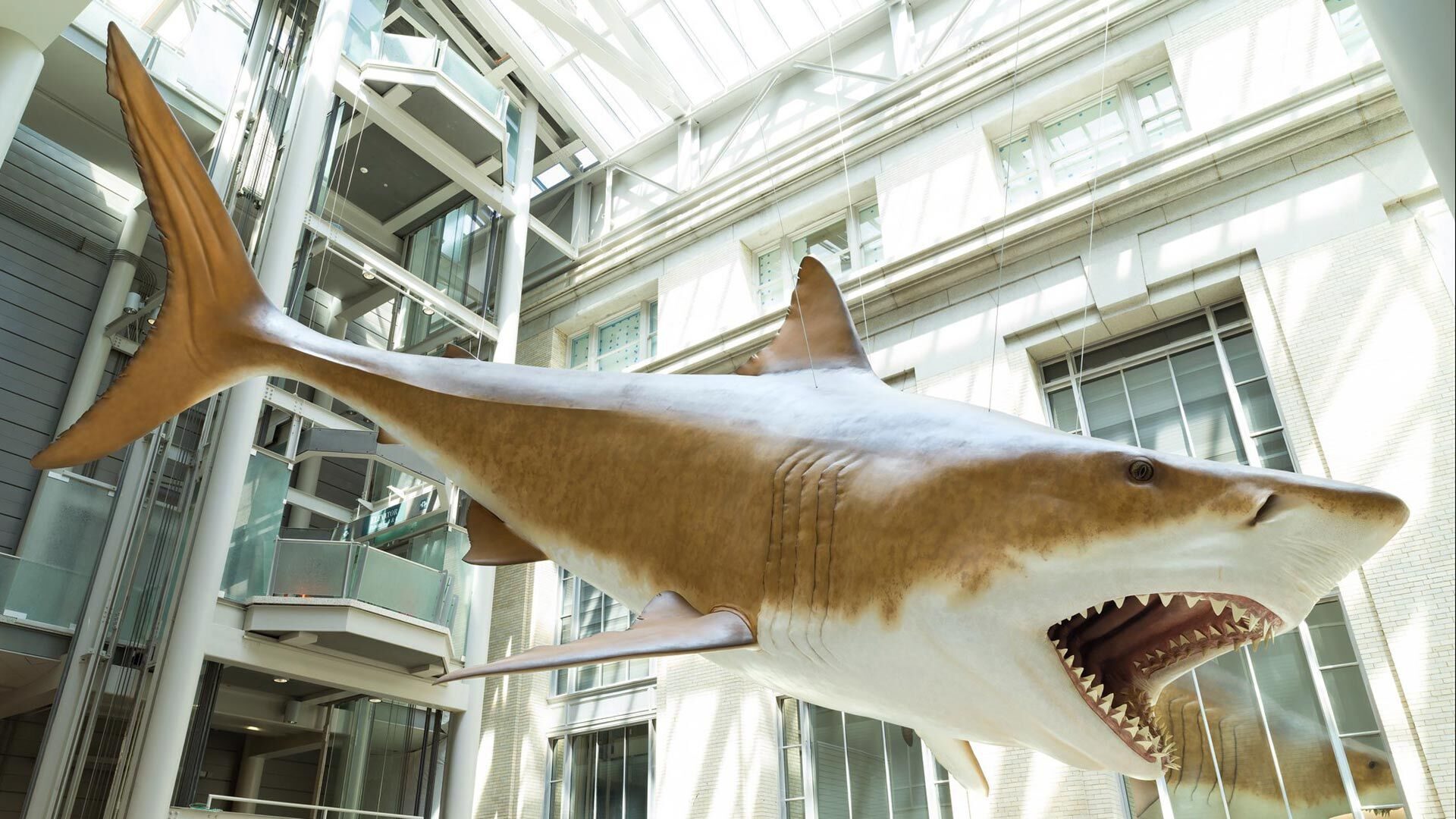- June 04, 2019
- By Kimbra Cutlip
Visitors to the Smithsonian’s National Museum of Natural History can now grab a bite eye-to-eye with a creature—a giant shark that lived between 3.6 and 20 million years ago—that could have polished off a whole table of them for lunch.
Bretton Kent, an instructor in the University of Maryland Department of Entomology, helped design the life-size 52-foot model of Carcharocles megalodon—a new feature of the museum’s renovated café meant to evoke the thrilling experience of visiting the David H. Koch Hall of Fossils-Deep Time. This reimagined dinosaur hall is scheduled to open Saturday.
Kent joined the design team led by Hans Sues, chair of the museum’s Department of Paleobiology, because he’s an authority on the fossils of the Chesapeake Bay region, one of the richest areas for megalodon fossils. He covered the scientific evidence on the physical description of this largest ever predatory fish in the Smithsonian’s 2018 book “The Geology and Vertebrate Paleontology of Calvert Cliffs, Maryland, USA.” We asked him a few questions about the project, as well as the massive shark that inspired it.
What happened to megalodon? Any chance any still survive in some deep, remote part of the ocean?
There’s no clear answer to why megalodon went extinct, and there were probably several factors involved. With a decline in global temperatures, there were new predators that could prey on juvenile megalodon, and the prey that megalodon relied on were evolving adaptations to live in cooler, higher latitude waters. Megalodon was probably mesothermic, meaning it had a body temperature slightly above that of the surrounding seawater. So as whales, which are true endotherms and likely the primary prey of megalodon, evolved the ability to survive in more polar waters, megalodon was unable to follow. This inability to survive in colder waters would also preclude megalodon from surviving in deeper ocean waters today.
How do scientists know what they looked like?
There are no complete megalodon skeletons. Most of what is known about them comes from fossil teeth and bite marks on the bones of other marine animals such as whales. With so little to go on, scientists make inferences based on related species and the relationships between form and function that would govern the appearance of such a large shark.
Megalodon fossils have been found throughout the world and in deep-sea sediments, suggesting that the shark lived an oceanic lifestyle. From living sharks, we know that most oceanic species evolved a distinct body shape—influenced by physics and biomechanics—that is most efficient for swimming long distances. Based on megalodon’s lifestyle and the function-driven forms of other ocean-dwelling sharks, we can infer its body shape as well as the relative size and placement of its fins.
What questions did the team need to answer to create the model?
The most speculative aspect of the reconstruction was the body color. For a large, open-ocean shark like megalodon, we would have every reason to expect that the body would exhibit countershading—in this case, a dark back and a white belly. This is an almost universal color scheme for large open-ocean fishes, because it helps them avoid detection. When they’re swimming below other fish, a dark back helps them blend in with the darkness below. When swimming above other fish, the white belly stands out less against sunlight or moonlight shining down through the surface of the water.
When the team was designing the megalodon model for the museum, the question was: What color is “dark” for the back? In modern open-water sharks, this can range from shades of gray and blue to brown or even purple. We have no way of knowing which is most appropriate for megalodon. We chose dusky brown, which is as reasonable as any.
What are the most fascinating unanswered questions about megalodon?
One may be whether it was a predator at all. Megalodon’s extreme size introduces some interesting issues regarding potential physiological constraints. For one thing, greater size puts greater demands on an animal’s circulatory system. Predatory fishes require a circulatory system that can support speed and bursts of energy.
Large predatory fishes also require adequate blood supply and warmth to portions of the brain that enable the fish to identify, track and accurately strike vulnerable areas of a prey animal’s body. There may be limits to the size of large predators due to these circulatory needs. The largest predatory fish living today is the great white shark, which is believed to be a distant relative of megalodon. Great whites are known to reach 23 feet in length, which is less than half of megalodon’s 50 to 60 feet.
Today, the only fishes that come close to megalodon’s length are slow-moving, docile filter feeders such as whale sharks and basking sharks, which are known to reach around 40 feet in length. With its large triangular cutting teeth, we know megalodon was not a filter feeder.
Rather, it may have been a scavenger that used its extreme size to intimidate other scavenging fishes away from a meal. This isn’t a widely held belief. And there is some evidence from bite marks on fossil whale bones to suggest megalodon was, indeed, a predator that killed live prey. But without more fossil evidence, we won’t be able to say for certain.
Topics
ResearchTags
Entomology